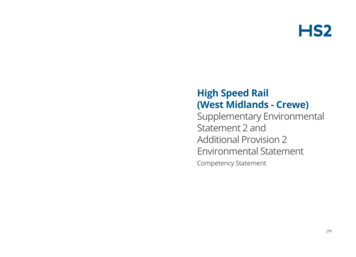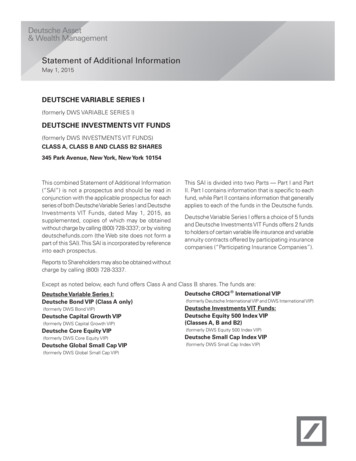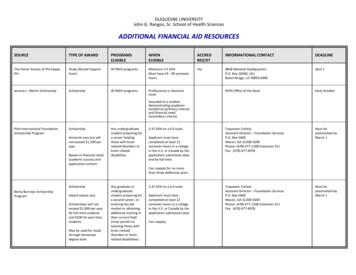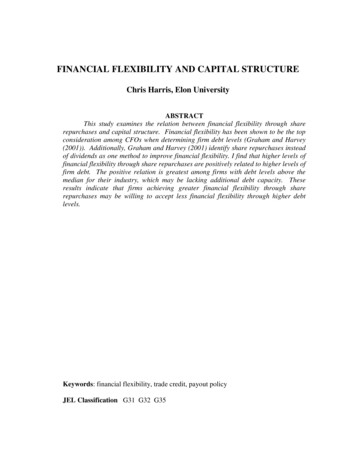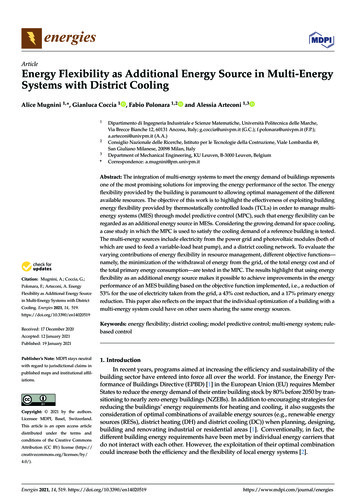
Transcription
energiesArticleEnergy Flexibility as Additional Energy Source in Multi-EnergySystems with District CoolingAlice Mugnini 1, *, Gianluca Coccia 1 , Fabio Polonara 1,2123* Citation: Mugnini, A.; Coccia, G.;Polonara, F.; Arteconi, A. EnergyFlexibility as Additional Energy Sourcein Multi-Energy Systems with DistrictCooling. Energies 2021, 14, 519.and Alessia Arteconi 1,3Dipartimento di Ingegneria Industriale e Scienze Matematiche, Università Politecnica delle Marche,Via Brecce Bianche 12, 60131 Ancona, Italy; g.coccia@univpm.it (G.C.); f.polonara@univpm.it (F.P.);a.arteconi@univpm.it (A.A.)Consiglio Nazionale delle Ricerche, Istituto per le Tecnologie della Costruzione, Viale Lombardia 49,San Giuliano Milanese, 20098 Milan, ItalyDepartment of Mechanical Engineering, KU Leuven, B-3000 Leuven, BelgiumCorrespondence: a.mugnini@pm.univpm.itAbstract: The integration of multi-energy systems to meet the energy demand of buildings representsone of the most promising solutions for improving the energy performance of the sector. The energyflexibility provided by the building is paramount to allowing optimal management of the differentavailable resources. The objective of this work is to highlight the effectiveness of exploiting buildingenergy flexibility provided by thermostatically controlled loads (TCLs) in order to manage multienergy systems (MES) through model predictive control (MPC), such that energy flexibility can beregarded as an additional energy source in MESs. Considering the growing demand for space cooling,a case study in which the MPC is used to satisfy the cooling demand of a reference building is tested.The multi-energy sources include electricity from the power grid and photovoltaic modules (both ofwhich are used to feed a variable-load heat pump), and a district cooling network. To evaluate thevarying contributions of energy flexibility in resource management, different objective functions—namely, the minimization of the withdrawal of energy from the grid, of the total energy cost and ofthe total primary energy consumption—are tested in the MPC. The results highlight that using energyflexibility as an additional energy source makes it possible to achieve improvements in the energyperformance of an MES building based on the objective function implemented, i.e., a reduction of53% for the use of electricity taken from the grid, a 43% cost reduction, and a 17% primary energyreduction. This paper also reflects on the impact that the individual optimization of a building with amulti-energy system could have on other users sharing the same energy : 17 December 2020Accepted: 12 January 2021Keywords: energy flexibility; district cooling; model predictive control; multi-energy system; rulebased controlPublished: 19 January 2021Publisher’s Note: MDPI stays neutralwith regard to jurisdictional claims inpublished maps and institutional affiliations.Copyright: 2021 by the authors.Licensee MDPI, Basel, Switzerland.This article is an open access articledistributed under the terms andconditions of the Creative CommonsAttribution (CC BY) license (https://creativecommons.org/licenses/by/1. IntroductionIn recent years, programs aimed at increasing the efficiency and sustainability of thebuilding sector have entered into force all over the world. For instance, the Energy Performance of Buildings Directive (EPBD) [1] in the European Union (EU) requires MemberStates to reduce the energy demand of their entire building stock by 80% before 2050 by transitioning to nearly zero energy buildings (NZEBs). In addition to encouraging strategies forreducing the buildings’ energy requirements for heating and cooling, it also suggests theconsideration of optimal combinations of available energy sources (e.g., renewable energysources (RESs), district heating (DH) and district cooling (DC)) when planning, designing,building and renovating industrial or residential areas [1]. Conventionally, in fact, thedifferent building energy requirements have been met by individual energy carriers thatdo not interact with each other. However, the exploitation of their optimal combinationcould increase both the efficiency and the flexibility of local energy systems [2].4.0/).Energies 2021, 14, 519. .com/journal/energies
Energies 2021, 14, 5192 of 30When a number of different energy sources are integrated into a building, this isreferred to as a hybrid or multi-energy system (MES). An MES is where electricity, heating,fuels, and other types of energy vectors interact optimally with each other at variouslevels [3]. Focusing on residential buildings, natural gas and electricity can be energysources for various generators, including boilers, electric heat pumps (HPs), chillers andcombined heat and power (CHP) systems, which can then be used to produce electricity,heating and cooling [3]. Furthermore, MESs can integrate RESs and use energy sourcesrecovered from optimized system management (e.g., harvesting energy from natural gasdistribution networks [4]). Furthermore, the interaction of buildings at the district level(e.g., heating or cooling energy in DH or DC) can be exploited, and building loads canbe easily shifted thanks to the different energy storage systems that can be integratedin MESs [5]. In this way, energy flexibility can be considered as an energy source in itsown right.Several configurations of multi-energy systems applied to buildings have been analyzed in the literature with the aim of showing their effectiveness in terms of efficiencyand sustainability. For instance, Aste et al. [6] introduced a fully renewable urban districtin which a low-temperature and small-sized wood biomass district thermal plant wasintegrated with groundwater heat pumps and solar photovoltaic (PV) systems. Energysimulation demonstrated that controlled exploitation of multiple energy sources in a district heating system allowed for greater self-consumption of renewable sources, with alow request for grid electricity. Liu et al. [7] determined a 40% reduction in CO2 emissionswhen a hybrid HVAC (Heating, Ventilation and Air Conditioning) system, consisting ofa CHP plant and a liquid-desiccant system, was used to match the power and thermaldemand of a demonstration building in Beijing, China.Other papers have focused on the identification of optimal operating strategies for specific MES systems in order to achieve specific energy objectives. For instance, Ren et al. [8]assessed a multi-objective optimization model in order to determine the optimal strategyfor a distributed energy source system. The case study comprised an energy system installed in an eco-campus in Japan, and included several different sources (photovoltaic,fuel cell, and gas engine). The minimization of two objective functions, i.e., energy costand CO2 emissions, was achieved by means of a compromise programming method. Theresults showed that the increase in the degree of satisfaction of economic objectives ledto increased CO2 emissions. To take into account the complex relationship among energysystems in MESs, Ruusu et al. [9] described a new energy management system for a varietyof energy flexibility conversion technologies and storage options in buildings by means ofa nonlinear optimization-based model predictive control (MPC) method.District heating and cooling systems are relevant resources in efficient multi-energysystems, and their integration with respect to building energy demand has received a greatdeal of attention. For instance, Aoun et al. [10] presented a MILP-based (mixed-integer linear programming) model predictive control in order to satisfy thermal demand in buildingsconnected to a district heating system. In particular, they investigated the exploitation ofthe thermal mass embedded in the building envelope to optimally schedule space heatingloads on the basis of weather conditions and energy cost variations. Luc et al. [11] alsoexploited the thermal mass of the buildings for the purpose of heat storage and evaluatedthe flexible operation potential of a small district with buildings connected to a districtheating network. Introducing different load shifting scenarios based on thermal demanddata and heat production cost in the Greater Copenhagen district heating system, theyobtained a potential load shifting of between 41% and 51% in all of the considered scenarios.Even Foteinaki et al. [12] investigated the potential for the flexible operation of low-energyresidential buildings in district heating systems. They demonstrated that, using the thermalmass of the building as a storage medium, the pre-heating strategy was highly effective forload shifting and peak load reduction (energy use was reduced in all scenarios by between40% and 87%). An analysis of the literature confirms the relevant role that the flexibilityprovided by thermostatically controlled loads can have in the optimal management of
Energies 2021, 14, 5193 of 30MESs. Furthermore, among the other resources of an MES, district cooling systems are verypromising systems for increasing the energy efficiency of the cooling sector [13], but thereare still few works considering their integration with building loads and their optimization,with much more emphasis having been given to district heating systems [14]. Coolingloads and thermal comfort in summer have their own specific characterizations that aredistinct from the winter season; therefore, an ad hoc analysis is needed. For example,Zabala et al. [15] presented the case of a district cooling with absorption machines, whoseproduction was controlled through a model predictive control. In the present paper, theintegration of district cooling systems with building energy demand is also investigated,but in contrast with previous works, the district cooling system is considered to be suppliedusing waste energy. This scenario is derived from the exploitation of cooling power from aparticular energy recovery process that has already been presented in a previous work [16],where the evaporation of liquefied natural gas in a fuel station was able to provide coldenergy to a small residential district cooling network. Therefore, the cooling power provided to the DC follows a given load curve and cannot be optimized, as in the literatureworks described above. Moreover, the objective of this work is focused at the buildinglevel, where the available cold energy is deployed at best in combination with the otherenergy sources composing the multi-energy system. The analysis aims to highlight theimportance of the activation of building energy flexibility provided by thermostaticallycontrolled loads (TCL), e.g., air conditioners and space cooling/heating systems. Suchflexible energy loads are assumed in this analysis to be additional virtual energy resourcesin the optimal management of a building multi-energy system that also integrates a districtcooling network.When an MES is integrated into a building, an advanced control method is necessaryto optimize the operational energy performance in a timely fashion. Thus, an MPC is considered for the analyzed case. Indeed, MPCs represent one of the most explored paradigmsin the academic literature for realizing intelligent energy management in buildings [17],due to its capability of combining the principles of feedback control and numerical optimization [18]. The potential of such control to provide demand-side flexibility in buildingswith multi-carrier energy systems has been discussed by Zong et al. [19]. They highlightthat an MPC-based BEMS (Building Energy Management System) controller is an efficientand feasible approach for managing the portfolio of energy usage in buildings. An MPCuses a dynamic model to predict the system response in order to select the best sequenceof control actions, taking into account both predictions of future disturbances and systemconstraints [20]. For short-term predictions, three categories of building energy modelsare available: white box, grey box and black box [21]. There are several contributions inthe literature regarding the performance evaluation of the different building modelingapproaches to be used in an MPC. Among others, Mugnini et al. [22] summarized theadvantages and disadvantages of a data-driven model based on an artificial neural network (ANN) and a physical-based model based on a thermal network of resistances andcapacitances to predict the building thermal demand in an operative MPC designed tominimize the total cost by using TLC flexibility. In a simplified case study, they highlightedthe improved performance of the physical-based model in the exploitation of the energyflexibility derived from thermostatically controlled loads.This paper presents, through the analysis of a case study, the manner in which theenergy flexibility of TCL can be exploited to optimally manage a multi-energy systemincluding district cooling. The manuscript is structured as follows: in Section 2, thegeneralized methodology for implementing an MPC in order to integrate different energysources (including a district cooling) in an MES in a building is presented. Section 3describes the case study, and in Section 4 the optimal control is applied to the case study.The results for the different objective functions are discussed in Section 5, while Section 6provides the main conclusions of the study.
Energies 2021, 14, 519Energies 2021, 14, 5194 of 304 of ept of the application is represented in Figure 1: different energy sources y,by
when a hybrid HVAC (Heating, Ventilation and Air Conditioning) system, consisting of a CHP plant and a liquid-desiccant system, was used to match the power and thermal demand of a demonstration building in Beijing, China. Other papers have focused on the identification of optimal operating strategies for spe-cific MES systems in order to achieve specific energy objectives. For instance, Ren .


